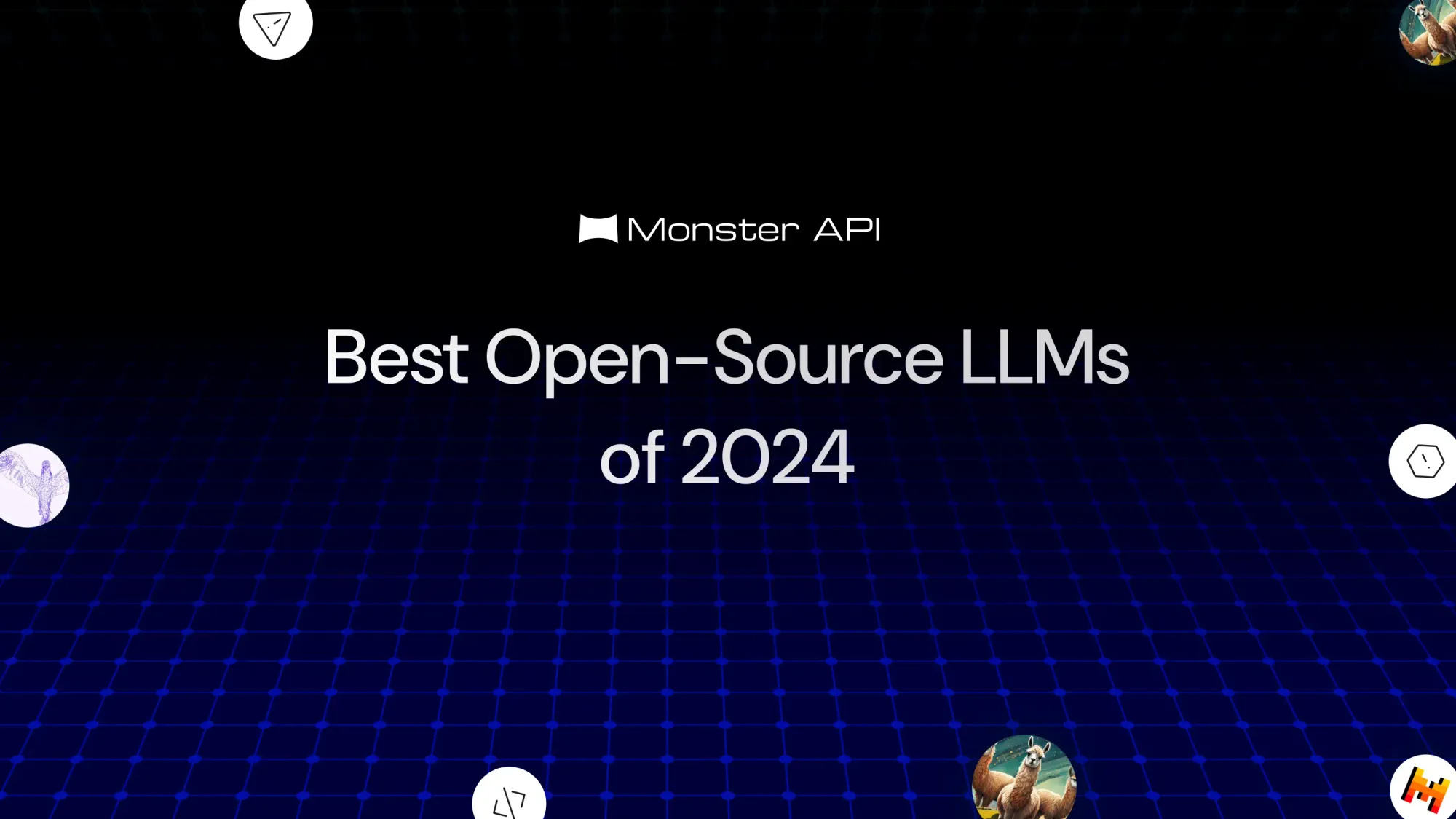9 Top Open-Source LLMs for 2024 & Their Use-Cases
In this post we've covered all the top-rated open source LLMs. We'll keep updating this list as new models drop.

Every day, the AI space is growing and it wouldn’t be possible without the wide range of SOTA large language models (LLMs). If you don’t know what LLMs are capable of, think of ChatGPT. ChatGPT, probably the most used chatbots in the world is powered by GPT-4, a LLM made by OpenAI.
ChatGPT, Gemini, and hundreds of other chatbots are powered by LLMs. However, top LLMs are closed sourced and users can use it only with a license. On the opposite end of the LLM spectrum are the open-source LLMs. As most LLMs are controlled by big tech such as Microsoft, Google, and Meta, Open-Source LLMs are a way for the general public to have access to generative AI.
In this article, we’ve compiled a list of the top 9 open-source LLMs of 2024.
Best 9 Open-Source LLMs for 2024
Building custom AI applications that fit your use-case and perform as you expect them requires choosing the right large language model. Here's our pick for the top 9 open-source LLMs:
1. LLaMa 3.1
Meta, surprisingly is leading the front with their state-of-the-art LLaMa models. On July 23, 2024, Meta released the LLaMa 3.1 model. LLaMa 3.1 came out 8B, 70B, and for the first time ever 405B parameters.
These models are pre-trained to handle a lot of natural language processing tasks fluently in multiple languages such as:
- English
- Spanish
- Portuguese
- German
- Thai
- French
- Italian
- Hindi, and more.
The models also offer an improved context length of 128,000 tokens which increase their ability to process and understand context better. The enhanced context length increases the model’s capabilities to handle complex reasoning tasks and handle longer conversations.
The LLaMa 3.1 405B model is a standout in this series, known for its synthetic data generation, which users can use to train other models. What makes the LLaMa 3.1 models even more impressive is that they can leverage reinforcement learning from human feedback (RLHF), ensuing models keep on learning from their conversations.
2. Stable LM 2
Second on our list is the new model from Stability AI - Stable LM 2. Stable LM 2 is a 1.6 billion-parameter language model designed to operate on standard laptop computers. Trained on 2 trillion tokens across seven languages—Dutch, French, German, Italian, Portuguese, Spanish, and English—Stable LM 2 leverages cutting-edge advancements in language modeling to deliver performance comparable to larger models.
Stable LM 2 is available in two versions: the base model and an instruction-tuned variant called Stable LM 2 Zephyr. The base model is trained on multilingual data, while Zephyr is fine-tuned for instruction-based tasks. The model is licensed under Stability AI's Non-Commercial Research Community License for non-commercial purposes, with commercial usage requiring a Stability AI Membership.
3. BLOOM
BLOOM is the epitome of the commitment of the open-source community. BLOOM was launched in 2022 after an year-long collaboration project from 70+ countries and researchers from HuggingFace. The model is an autoregressive LLM that is trained to continue text from a prompt on a huge amount of text data.
BLOOM was considered a landmark in the GenAI space as it’s one of the most powerful open-source LLMs with 176B parameters. As per HuggingFace, BLOOM is able to understand text and provide coherent answers in 46 languages and 13 programming languages.
The collaborators have made sure that BLOOM is a project that’s completely transparent and everyone can access the source code and the training data to run, study, and improve it.
4. BERT
Developed by Google in 2017 and launched in 2018, BERT is one of the best open-source models available today. BERT stands for Bidirectional Encoder Representations from Transformers. Very quickly BERT achieved spectacular performance in a lot of natural language processing tasks.
BERT was one of the most advanced LLMs in the early days of open-source LLMs and became widely popular. In 2020, Google announced that they’ve adapted BERT through Google Search in over 70 languages.
BERT is an overall great model if you want to fine-tune for your specific use-case such as sentiment analysis, text classification, and more.
5. Falcon 180B
Falcon 180B is another spectacular open-source large language model that’s designed for efficient language understanding & processing. The Falcon 180B relies on the transformer-based architectures to achieve quick processing of text datasets. It’s one of the best models for real-time applications that require quick and accurate responses.
Users can fine-tune Falcon 180B to fit their particular use case such as social media research, chatbots, text classification, sentiment analysis, and much more. All Falcon models are available on MonsterAPI for fine-tuning.
6. OPT-175B
Another open-source model from Meta for their quest to push forward the open-source LLM industry. OPT stands for Open Pre-Trained Transformers Language Models and they were launched in 2022.
OPT is made up of decoder-type pre-trained transformers ranging from 125M to 175B parameters. This makes the OPT-175B one of the most advanced open-source LLMs in the market. On some benchmark tests, it offers similar performance to GPT-3.
However, the OPT-175B is available under non-commercial license, allowing the use of the model for only research use cases.
7. XGEN-7B
Salesforce is also competing in the open-source LLM race. They released the XGen-7B in July 2023. As per the authors of the model, most LLMs today only focus on providing large answers to short prompts. However, XGen-7B is for building a tool that supports longer context windows.
For example, the most advanced XGen has an 8K context window, which is the cumulative size of the input and output text.
Compared to some of the most powerful open-source LLMs, XGen is relatively small with only 7B parameters for training. Although, despite its small size, XGen is able to deliver great results, the model is available for commercial and research purposes.
8. GPT-NeoX & GPT-J
Built by EleutherAI, GPT-NeoX and GPT-K are open-source models. GPT-NeoX has 20 billion parameters, while GPT-J has 6 billion parameters, and both the models can deliver great results with accuracy.
Both the models are trained with 22 high-quality datasets from a diverse set of sources that enable their use in multiple domains and many use cases. But, unlike GPT-3, GPT-NeoX and GPT-J haven’t been trained with RLHF.
GPT-NeoX and GPT-J can be fine-tuned to perform a range of tasks like text generation, text classification, sentiment analysis, and much more.
9. Mistral 7B LLM
Mistral 7B is another model developed by Mistral AI, it’s a 7.3B parameter model that outperforms LLaMa 2 13B on multiple benchmarks. The model is designed for both English language tasks and coding tasks, making it a versatile tool for a wide range of applications.
Fun fact about Mistral 7B – It was developed in just 3 months, during which Mistral AI team assembled a top-performance MLops stack and designed a sophisticated data processing pipeline.
You can Fine-tune Mistral 7B on MonsterAPI and use it for a range of tasks that fit your use-case.
How to Choose the Right Open-Source LLM for Your Needs?
The open-source landscape for large language models (LLMs) is rapidly evolving, with more open-source options available today than proprietary ones.
As developers across the globe collaborate to improve and optimize these models, it can be challenging to decide which open-source LLM best fits your needs. Before you choose an open-source model for building custom AI models, here are some things to consider:
- Clarify Your Objective
The first step is to clearly define what you want to achieve. While open-source LLMs are accessible to everyone, some may only be available for research purposes. If you’re building a business, it's essential to review the licensing terms, as some models may impose restrictions on commercial use.
- Do You Really Need an LLM?
Although LLMs are highly popular and offer numerous possibilities, they aren’t always necessary. Before deciding on an LLM, evaluate whether your project genuinely requires one. If your goals can be met without an LLM, you might save both time and money, as well as avoid the high computational demands that LLMs often require.
- How Important is Accuracy?
Accuracy is closely tied to the size of the model. In general, larger LLMs, with more parameters and extensive training data, offer greater accuracy. If your application demands high precision, models like LLaMA or Falcon, which are known for their larger sizes, may be more suitable.
- What is Your Budget?
Bigger models require more resources to train, deploy, and maintain. This translates to higher infrastructure costs or larger cloud computing bills. While open-source LLMs can eliminate some licensing fees, operating them at scale still requires significant investment. Be sure to balance your need for performance with your available budget.
- Can a Pre-trained Model Meet your Needs?
Instead of training a model from scratch, consider using a pre-trained LLM that fits your use case. Many open-source LLMs have been fine-tuned for specific applications. If one of these aligns with your goals, it may be a more cost-effective and efficient solution.
Choosing the right LLM involves carefully weighing these factors to ensure the model you select aligns with your goals, resources, and constraints.
Conclusion
The open-source LLM movement is gaining incredible momentum. As these models evolve rapidly, it's becoming clear that the generative AI space may no longer be dominated solely by big tech companies with vast resources.
While we've seen only a handful of prominent open-source LLMs so far, the actual number is much larger and continues to grow swiftly. By fine-tuning large language models, you can build custom applications that make your life a bit easier.

